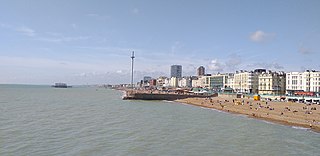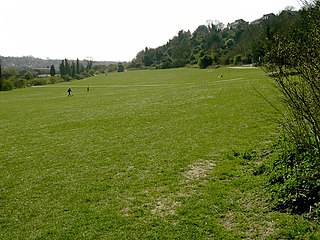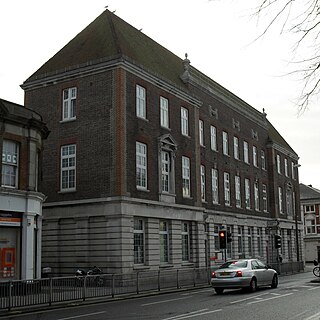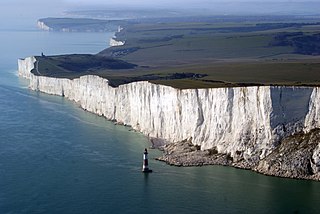
Brighton and Hove is a city and unitary authority in East Sussex, England. It consists primarily of the settlements of Brighton and Hove, alongside neighbouring villages.

The South Downs are a range of chalk hills that extends for about 260 square miles (670 km2) across the south-eastern coastal counties of England from the Itchen valley of Hampshire in the west to Beachy Head, in the Eastbourne Downland Estate, East Sussex, in the east. The Downs are bounded on the northern side by a steep escarpment, from whose crest there are extensive views northwards across the Weald. The South Downs National Park forms a much larger area than the chalk range of the South Downs and includes large parts of the Weald.

Worthing is a seaside town in West Sussex, England, at the foot of the South Downs, 10 miles (16 km) west of Brighton, and 18 miles (29 km) east of Chichester. With a population of about 110,000 and an area of 12.5 square miles (32.4 km2), the borough is the second largest component of the Brighton and Hove built-up area, the 15th most populous urban area in the United Kingdom. Since 2010, northern parts of the borough, including the Worthing Downland Estate, have formed part of the South Downs National Park. In 2019, the Art Deco Worthing Pier was named the best in Britain.

The South Downs National Park is England's newest national park, designated on 31 March 2010. The park, covering an area of 1,627 square kilometres (628 sq mi) in southern England, stretches for 140 kilometres (87 mi) from Winchester in the west to Eastbourne in the east through the counties of Hampshire, West Sussex and East Sussex. The national park covers the chalk hills of the South Downs and a substantial part of a separate physiographic region, the western Weald, with its heavily wooded sandstone and clay hills and vales. The South Downs Way spans the entire length of the park and is the only National Trail that lies wholly within a national park.

Cissbury Ring is an 84.2-hectare (208-acre) biological Site of Special Scientific Interest north of Worthing in West Sussex. It is owned by the National Trust and is designated a Scheduled monument for its Neolithic flint mine and Iron Age hillfort.

Findon is a semi-rural clustered village and civil parish in the Arun District of West Sussex, England, 4 miles (6.4 km) north of Worthing.

Durrington is a neighbourhood and former civil parish in the Borough of Worthing in West Sussex, England. Historically in Sussex, in the rape of Bramber, it is situated near the A27 road, 2.3 miles (3.7 km) northwest of the town centre. Since 1992 it has been home to the community-led Durrington Festival.

High Salvington is a neighbourhood of the borough of Worthing in West Sussex, England. It is centred 2.5 miles (4.0 km) northwest of the town centre and is north of the A27.

Findon Valley is a neighbourhood of the Borough of Worthing in West Sussex, England. It lies on the A24 road 2.9 miles (4.7 km) north of the town centre.

Worthing Borough Council is a district council in the county of West Sussex, based in the borough of Worthing. The borough council was created in 1974 under the Local Government Act 1972 out of the existing Worthing Municipal Council, which also had borough status. It forms the lower tier of local government in Worthing, responsible for local services such as housing, planning, leisure and tourism. Since 2014 it has been a constituent council of the Greater Brighton City Region.

Cissbury is an electoral division of West Sussex in the United Kingdom, and returns one member to sit on West Sussex County Council.

Worthing is a large seaside town in Sussex, England in the United Kingdom. The history of the area begins in Prehistoric times and the present importance of the town dates from the 19th century.

St Andrew's Church is the Church of England parish church of Tarring, West Sussex, England. Founded in the 11th century in a then rural parish which had earlier been granted to the Archbishop of Canterbury, the church remained a peculier of Canterbury for many centuries thereafter. It served nearby parishes when their churches fell into disrepair, John Selden was baptised here, and the church became a base for smuggling. The present building is mostly 13th-century, and its tall spire is a landmark in the area. The church is a Grade II* Listed Building.

Worthing, a seaside town in the English county of West Sussex which has had borough status since 1890, has a wide range of public services funded by national government, West Sussex County Council, Worthing Borough Council and other public-sector bodies. Revenue to fund these services comes principally from Council Tax.

Worthing Golf Club is a golf club on the South Downs at Worthing, England. Located close to the Iron Age hill fort of Cissbury Ring in the new South Downs National Park, the club comprises two links golf courses, a driving range and a clubhouse. The club enjoys panoramic views both of the South Downs and the English Channel.
A wide variety of sport in Worthing has been played, which has a long and interesting history.

The Eastbourne Downland Estate is an area of downland at the easternmost end of the South Downs National Park in East Sussex, England. It was bought by the public, following threats to the beauty spots of Beachy Head and the surrounding farmland, which led to a public campaign and Act of Parliament in 1926. It is currently owned and managed, on behalf of the public, by Eastbourne Borough Council.

The following is a timeline of the history of the borough of Worthing, West Sussex, England.





















